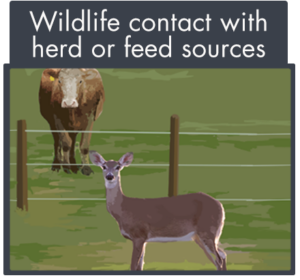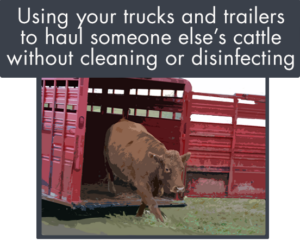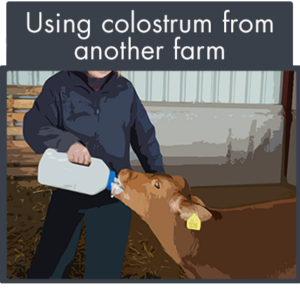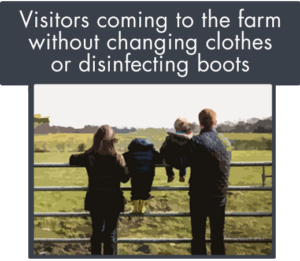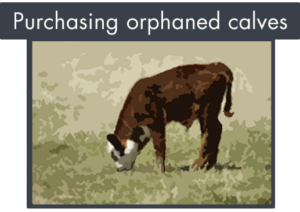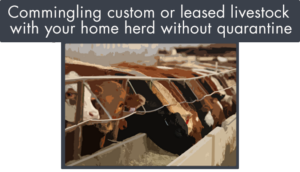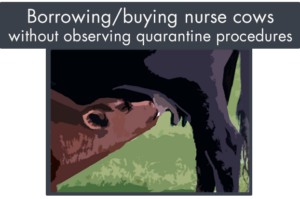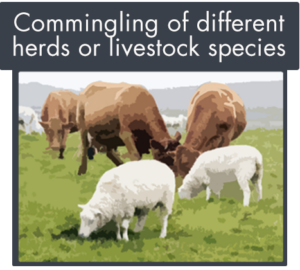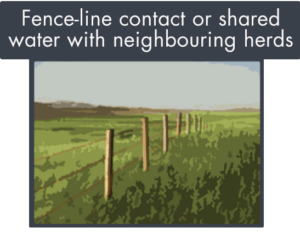The Best Offense is Defense: 15 Plays to Keep Your Beef Herd Safe 🎙️
CLICK THE PLAY BUTTON TO LISTEN TO THIS POST:
Listen to more episodes on BeefResearch.ca, Spotify, Apple Podcasts, Amazon Music or Podbean.
As humankind evolved from a nomadic hunter-gatherer society into agricultural-based settlement populations, there is a reason domesticated bovine played a major role as a farmed species. Cattle are hardy and resilient, defending themselves against many potentially harmful viruses, bacteria and parasitic burdens. That said, as their caregivers, there are scenarios where beef cattle producers can help ease that burden by implementing some simple barriers against disease to keep their herds productive and healthy.
1. Grazing leases and shared pastures
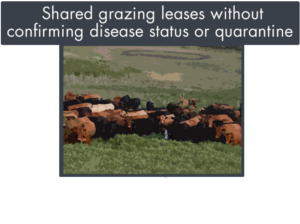
Producers can play a proactive role in community grazing situations by ensuring animals with a poor body condition score, or showing signs of possible illness, are not shipped to a community pasture. While there, pasture staff should have a standardized protocol for vaccination, disease identification and treatment while animals are at the community pasture, and they should work closely with a veterinarian when things aren’t looking right.
Remember cattle coming out of community pastures or grazing leases can bring unwanted diseases home like those that cause fetal loss such as bovine viral diarrhea virus (BVD) or infectious bovine rhinotracheitis (IBR), even if they appear healthy. To avoid spreading these to the main herd, it is recommended to manage them separately for 3-4 weeks before rejoining the core group.
2. Wildlife contact
Identifying key areas on the farm where beef cattle potentially comingle with wildlife is a key factor when considering the risk of transmission of infectious diseases to a herd. For example, when cattle share pastures and water sources with other cloven-hooved animals such as deer and elk, diseases such as tuberculosis can spread between cohorts. Additionally, close contact with wild birds and other wildlife and their droppings should also be limited as much as possible to prevent cross-contamination between species.
3. Shared trailers and equipment
Farmers often work together in busy seasons to be more efficient with their time and resources. When agreeing with a neighbor to work together, consider having a conversation about the risk factors associated with possible cross-contamination between farms, and make every effort to minimize those risks. Some jumping-off points include ensuring both herds have a similar vaccination and health status and thoroughly cleaning the shared equipment between uses.
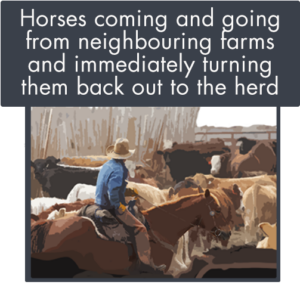
4. Horse lending
When lending a hand to the neighbors we often think about cleaning our trailers and washing our boots, but what about horses? When a horse has spent time in a neighboring herd, there should be adequate time and measures taken to ensure they are not bringing home pathogens on their feet or in their respiratory tracts, so some level of quarantine is recommended.
5. Livestock shows
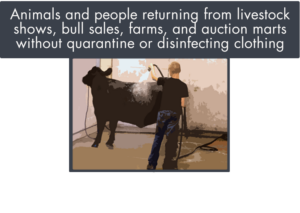
The comingling of people, equipment and animals at 4-H events, local fairs, livestock shows and markets pose a large risk to farming operations. Any animals or equipment returning from these events must be thoroughly cleaned, disinfected and quarantined.
6. Raw colostrum from other farms
Cows from within your own herd will have the best antibody profile in their colostrum to protect your calves from the diseases persistent in your environment. Raw colostrum from other farms, especially dairies, may not include all the antibodies to protect against the diseases that threaten your herd.
Worse than that, it could also contain dangerous viruses, bacteria or parasites that are not part of your environment already. Introducing pathogens such as highly pathogenic avian influenza, Johne’s disease, Cryptosporidium, and scours-causing organisms can cause devastating results. If you have calves that require colostrum but have none from your herd on hand, opt for pasteurized powdered colostrum instead.
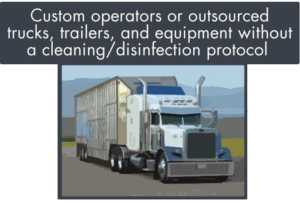
7. Custom operators
Custom workers often travel from farm to farm to provide services. While this is convenient and often time-saving for a producer, it also creates a risk if the contractor is not following biosecurity recommendations. Ensure all contractors are aware of your biosecurity protocols and that they are responsible for complying. This can include spraying tires, boot baths and wearing booties on-farm.
8. Farm visitors
Off-farm family and friends are often excited to experience the farm, and beef producers are welcoming and enjoy sharing a glimpse into their lifestyle. When offering access to farm visitors, it is equally important to ensure simple steps are taken to protect the animals on the farm. These may include boot washes, clothing changes and hand washing.
9. Orphaned calves
The economic consequences of having a dry cow for the season are significant. Because of this, it is tempting to adopt a calf from another operation onto a willing mother cow. However, the risks outweigh the reward.
Orphaned calves will carry all the pathogens they have been exposed to on their farm of origin. These pathogens may not harm the orphan calf, as they will have exposure immunity from their herd of origin. Those same pathogens, however, may be novel to your herd and could have devastating consequences for your cows and calves in the forms of scours outbreaks or reproductive wrecks.
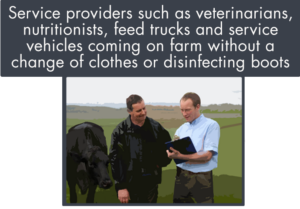
10. Service providers
Veterinarians, feed consultants and nutritionists have the best intentions in providing critical advice to help your herd stay healthy and remain profitable. They often travel between farms, so it is crucial they follow biosecurity protocols when entering and leaving the farm.
11. Leased livestock
Custom feeding and leased livestock can help bolster income when needed. Animals that do not originate from your herd will need to be quarantined and placed on the same vaccination program as the rest of your herd, in consultation with your veterinarian, before fully integrating into your herd.
12. Purchased stock
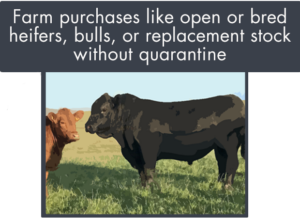
Bulls, replacement heifers and any other newly purchased animals will not have the same immunity as your home herd. They must be properly vaccinated and quarantined to ensure they don’t introduce disease to your herd, or vice versa.
13. Borrowed or purchased nurse cows
Nurse cows can pose a significant threat to the health status of your herd by introducing new pathogens to your calves and cows that they could be naive to. When acquiring a nurse cow from another operation, it is key to allow for an adequate amount of time to properly quarantine and evaluate the health of the incoming animal
14. Different livestock species
Just because an animal is a different species doesn’t mean it cannot still carry or spread disease to the cow herd. Care must be taken when introducing new species onto the farm, such as small ruminants like sheep and goats, pigs and horses.
15. Fence-line contact and shared water
If your cows are sharing a fence line or a water source with a neighbouring herd, their problems become your problems. Any cattle that are across fence or drinking from the same water source will need to be considered when assessing risk and developing vaccination protocols.
While it is not possible to protect your herd from everything all the time, understanding where the potential breaches are in your biosecurity plan can help identify reasonable changes in management and develop health and vaccination protocols that effectively protect your herd.
LEARN MORE:
- Think You Have a Closed Herd? (BCRC post)
- Biosecurity (BCRC topic page)
- Until the Cows Come Home: Five Strategies to Stop Sickness Before It Starts This Fall (BCRC post)
- Foot and Mouth Disease (BCRC topic page)
- Stopping Johne’s Disease in Its Tracks: What’s the Best Testing Strategy for Your Herd? (BCRC post)
- Bovine TB: Understanding the Disease and How It Is Managed in Canada (BCRC post)
- Getting the Dirt on Cleaning vs. Disinfecting (BCRC post)
- Vaccination Resources (BCRC post)
Sharing or reprinting BCRC posts is welcome and encouraged. Please credit the Beef Cattle Research Council, provide the website address, www.BeefResearch.ca, and let us know you have chosen to share the article by emailing us at [email protected].
Your questions, comments and suggestions are welcome. Contact us directly or spark a public discussion by posting your thoughts below.
